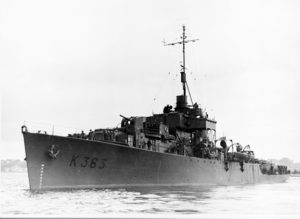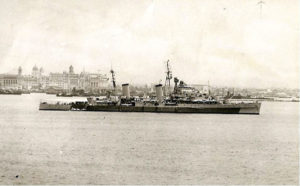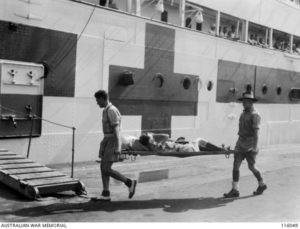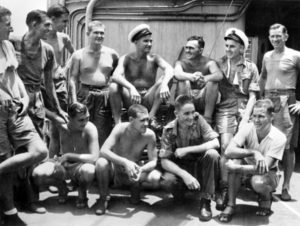By Max Thomson
HMAS PERTH survivors were the subject of a special request tabled to authorities when Changi prisoners of war were released in Singapore following Japan’s surrender in 1945. The Australian warship despatched to Singapore to escort home transports carrying Australian prisoners-of-war from Changi arrived in Singapore on the day Admiral Lord Louis Mountbatten accepted the formal surrender of the Japanese there from Lt. General Itagaki.
The warship’s Commanding Officer made a special request to the authorities seeking permission for the HMAS Perth men to be allowed to travel back home to Australia on the RAN warship, following their years of privation after the cruiser’s sinking in Sunda Straits in a memorable action against overwhelming Japanese forces.
How it all came about is a fascinating chapter in our naval history. After a year of endless long-range convoy escort assignments that took the ship to many parts of the Philippines, Borneo, the Celebes, the Marshalls, Palau and a host of other places, the 2200-tonne RAN frigate HMAS Hawkesbury was ordered south for a refit. She entered Sydney Heads on the day ‘Enola Gay’ dropped the atomic bomb on Hiroshima. But instead of a Sydney stopover, the warship’s refit was switched to Williamstown and Hawkesbury was off the Victorian/NSW border when radio news was received that Japan had surrendered. Shortly afterwards, the frigate was ordered to return to Sydney.

Back in Sydney, Hawkesbury retrieved her 4-inch ammunition and much other equipment that had been put ashore ready for the refit. And truckload after truckload of special stores were taken aboard. Rumours were rife – but no-one was quite sure of what lay ahead. On August 27, HMAS Hawkesbury raised steam and slipped from the Cruiser Wharf at Garden Island. Straightening up on a course that would take the ship up the east coast again, Lt. Cdr. I.K. Purvis RAN (later Commodore Purvis, OBE) cleared lower deck and told the assembled ship’s company of the memorable assignment that lay ahead: to escort the relief ship Duntroon to Singapore, to be present at the surrender of the Japanese; then to escort home the transports bringing home 8th Division AIF prisoners of war, the HMAS Perth survivors and also released civilian internees. Steaming hard, Hawkesbury overtook Duntroon which had left Sydney a day ahead of her. She took up station ahead of the transport and course was set for Darwin, where immense amounts of stores and other equipment were added to those already loaded onto Duntroon. The whole of Darwin seemed to turn out on September 4 to farewell Duntroon and HMAS Hawkesbury on their relief mission.
With some degree of uncertainty as to whether all Japanese units knew – or would observe – the surrender settlement, Duntroon and Hawkesbury assumed wartime status, steaming at night without navigation lights and with the frigate’s 4-inch crews closed up and ready for emergency. Using its acoustic gear, Hawkesbury led Duntroon through the minefields approaching Singapore – through a passage blasted open by minesweepers of the Royal Navy.
Anchoring in Singapore Roads, HMAS Hawkesbury found herself surrounded by much of the might of the Royal Navy. HMS Cleopatra flew the flag of the Commander-in- Chief, East Indies Station (Admiral Sir A.J. Power). The battleship HMS Nelson flew the flag of Vice Admiral H.T.C. Walker, (Commanding the Third Battleship Squadron) and the French battleship FS Richelieu flew the flag of Rear Admiral Holland, Senior Officer of Force ‘N’. The warships Sussex, Royalist, Ceylon and a host of destroyers and frigates were ships of the Royal Navy that had won battle honours in many of the war’s engagements.

The fleet was dressed for the occasion – and the ‘Voice of Singapore’ radio gave credit to the arrival of HMAS Hawkesbury and Duntroon, in Singapore. But amid all that, 8th Divvy ex POW’s commandeered small craft and anything that floated to get out to the Aussie warship until Hawkesbury’s own boats began a regular ferry service from Clifford Pier that brought 200 aboard every morning, 200 of an afternoon and many more than that each evening.
Every man received as good a meal as a warship could provide, a cherished bottle of Australian beer plus newspapers, magazines and first-hand news of events back home. The good meal proved too much for many of the POWs to accommodate. Over the ensuing days, Hawkesbury really played host to the 8th Div. AIF – a routine interrupted only by a convoy assignment to escort merchantmen back through the minefields to open sea on those occasions when the RAN frigate was ‘duty ship’.
Ashore, the ship’s crew mingled with the POWs, went to Changi, and had the satisfaction of seeing Japanese working parties cleaning up Singapore. After disappointments and delays, which must have frustrated the POWs so anxious to head for their homeland, the final time of departure was pinpointed. Duntroon, laden with POWs and civilian internees, lay in Singapore Roads awaiting the transport Arawa which was to join her. In those days ships of the RAN flew the same white ensign worn by the Royal Navy’s warships. Determined to show the Australian troops that an Aussie warship was to escort them home, HMAS Hawkesbury flew an outsized Australian blue ensign from its yardarm – and blasted forth Waltzing Matilda and Homeward Bound from its loud-hailer systems. All to the tumultuous cheers from the troops who had clambered to every point of vantage aboard Duntroon and Arawa.

The Dutch hospital ship Oranje was among the first to leave with hospitalised cases – escorted by the RN destroyer Verulam. Hawkesbury’s convoy was scheduled to sail at 0700 but delays put this time back to 1400 which barely got the convoy through the minefields before darkness.
That departure scene was memorable. Indeed, it was historic. With HMAS Hawkesbury in the van, the troopships Duntroon and Arawa took up station in line astern plus the merchantman City of Worcester seeking safe escort through the minefields. Bands played aboard the capital ships, bugles blasted salutes, flags flew and signal lamps hammered out messages of goodwill as the 8th Div AIF – and the HMAS Perth survivors – set sail for home after three and a half years of privation as prisoners of the Japanese.
As the Singapore skyline began to fade, along with all its memories for the POWs, Hawkesbury made a signal which read: ‘To all prisoners of War: And so we say farewell to this shining jewel of the Orient famed for its luxury, music, good living and beautiful women. Onward to Aussie … Land of the Blessed’. Back from the CO of troops came the reply: ‘We appreciate your message. The little Chinese girls in their immaculate slacks will remain always in their memories as will the kindness of the Chinese to the prisoners. Luxury is all here – but bankrupt’.

Pictured, left to right: Petty Officer (PO) Ernest Robinson of Sydney, NSW; Chief Petty Officer (CPO) Joseph Hughes of Sydney, NSW; Able Seaman (AB) Edmund Clark of WA; Stoker Alan Axton of Vic; PO Charles Thomson of WA; CPO Wilfred Barnes of Sydney, NSW; PO Edward Tyrrell of Vic; CPO Robert Bland of Sydney, NSW; AB Cyril Woodman of SA; AB Eric Hurst of WA; Stoker Clive Henry of Vic, and Stoker Herbert Mynard of Vic. (AWM 19407)
Twice a day the Hawkesbury circled the troopships, giving them a break from the routine and enabling the frigate’s crew to see the POWs gaining strength each day as they ate good meals and basked in the sunshine firm in the knowledge that they were at last headed for home. Crewmen from Hawkesbury – one representative of each state – broadcast a summary of what highlights had taken place back home while the POWs had been incarcerated in Japanese camps. Off Timor, Hawkesbury received radio instructions to detach from its convoy and return towards Singapore. Transferring mail to Duntroon, Hawkesbury made the troopships a salute as she came about and steamed back towards Singapore. In darkness she exchanged signals with the British destroyer escorting the transports Esperance Bay, and Largs Bay, carrying more 8th Div AIF men and civilian internees.
Back 600 miles, HMAS Hawkesbury took over escort of yet another transport – Highland Chieftan – from HMS Paladin. Once more Hawkesbury set course for Australia. On September 30 she signalled ‘Australia in sight on our port bow. Welcome Home.’ Imagine what that meant to the Australian troops. In Singapore, Hawkesbury had sought permission for the HMAS Perth prisoners of war to travel home on the frigate. Authorities indicated this could be granted ONLY if the RAN warship could guarantee the men would be transported to Sydney which, of course, could not be assured. And, as it turned out, Hawkesbury did not actually get to Sydney for another four months.
Off Darwin, Hawkesbury was detached – this time to go to Timor to participate in surrender ceremonies there, at Koepang; followed by comprehensive surveillance missions throughout the Celebes, Borneo and islands of what were then the Dutch East Indies. It was four months – and a myriad of other assignments – before HMAS Hawkesbury was finally to get to Sydney. Yet no warship of the Royal Australian Navy had a finer and more satisfying climax to war’s end than HMAS Hawkesbury’s mission to go to Singapore and help return to their homeland men of the 8th Div AIF and the men who had survived firstly the sinking of HMAS Perth then the horrors of prisoner-of- war life in Changi and other prison camps.
Source
This Story was first published in the March 1988 edition of the Naval Historical Review. (all rights reserved).




